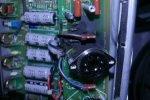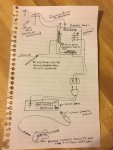Steenamaroo
...
Yeah, I don't know anything about US specifics or these amps in particular but I can echo the above.
In UK that third pin is simply to ensure that you are not the path to ground in the event of equipment failure.
If the chassis becomes live for any reason, that third pin is the path of least resistance and, depending on current flow, your fuse will blow to save the gear.
Ever hear the phrase, 'a little bit of knowledge can be a dangerous thing'?
I received a hotrod 2x12 for repair from a guy who said he powered it up to test...played for 5 minutes, went to make a cup of tea, and came back to a room full of smoke.
Some super-logical previous owner had thought well...the amp hums so I'll cut the chassis mains earth connection.
It also seems to blow fuses once in a while so I'll just stick in a 5amp fuse instead of the 1 amp or whatever it was.
One of the valves had shorted internally allowing large current to flow across a resistor. That should probably have blown the fuse and saved the amp but didn't.
That resistor terminated to ground/chassis so the chassis would have been live for the duration.
The damage pictured, was probably worse than it looks with several traces being charred through.
Swings and roundabouts, though. I cut away all the char and point-to-point repaired it, but after explaining all this to the man he asked me to keep it!
His intention was to sell the amp and although my repair is sound, neither of us was comfortable sending it into the wild!

In UK that third pin is simply to ensure that you are not the path to ground in the event of equipment failure.
If the chassis becomes live for any reason, that third pin is the path of least resistance and, depending on current flow, your fuse will blow to save the gear.
Ever hear the phrase, 'a little bit of knowledge can be a dangerous thing'?
I received a hotrod 2x12 for repair from a guy who said he powered it up to test...played for 5 minutes, went to make a cup of tea, and came back to a room full of smoke.
Some super-logical previous owner had thought well...the amp hums so I'll cut the chassis mains earth connection.
It also seems to blow fuses once in a while so I'll just stick in a 5amp fuse instead of the 1 amp or whatever it was.
One of the valves had shorted internally allowing large current to flow across a resistor. That should probably have blown the fuse and saved the amp but didn't.
That resistor terminated to ground/chassis so the chassis would have been live for the duration.
The damage pictured, was probably worse than it looks with several traces being charred through.
Swings and roundabouts, though. I cut away all the char and point-to-point repaired it, but after explaining all this to the man he asked me to keep it!
His intention was to sell the amp and although my repair is sound, neither of us was comfortable sending it into the wild!





